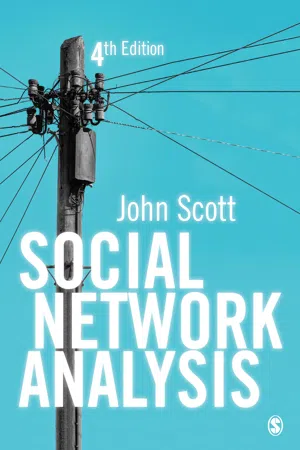
- 248 pages
- English
- ePUB (mobile friendly)
- Available on iOS & Android
eBook - ePub
Social Network Analysis
About this book
Incorporating the most important and cutting-edge developments in the field, this bestselling text introduces newcomers to the key theories and techniques of social network analysis and guides more experienced analysts in their own research.
New to This Edition:
New to This Edition:
- A chapter on data collection, covering a crucial phase of the research process
- Fully updated examples reiterate the continued importance of social network analysis in an increasingly interconnected world
- Detailed 'Further Reading' sections help you explore the wider literature
- Practical exercises including real-world examples of social networks enable you to apply your learning
Frequently asked questions
Yes, you can cancel anytime from the Subscription tab in your account settings on the Perlego website. Your subscription will stay active until the end of your current billing period. Learn how to cancel your subscription.
At the moment all of our mobile-responsive ePub books are available to download via the app. Most of our PDFs are also available to download and we're working on making the final remaining ones downloadable now. Learn more here.
Perlego offers two plans: Essential and Complete
- Essential is ideal for learners and professionals who enjoy exploring a wide range of subjects. Access the Essential Library with 800,000+ trusted titles and best-sellers across business, personal growth, and the humanities. Includes unlimited reading time and Standard Read Aloud voice.
- Complete: Perfect for advanced learners and researchers needing full, unrestricted access. Unlock 1.4M+ books across hundreds of subjects, including academic and specialized titles. The Complete Plan also includes advanced features like Premium Read Aloud and Research Assistant.
We are an online textbook subscription service, where you can get access to an entire online library for less than the price of a single book per month. With over 1 million books across 1000+ topics, we’ve got you covered! Learn more here.
Look out for the read-aloud symbol on your next book to see if you can listen to it. The read-aloud tool reads text aloud for you, highlighting the text as it is being read. You can pause it, speed it up and slow it down. Learn more here.
Yes! You can use the Perlego app on both iOS or Android devices to read anytime, anywhere — even offline. Perfect for commutes or when you’re on the go.
Please note we cannot support devices running on iOS 13 and Android 7 or earlier. Learn more about using the app.
Please note we cannot support devices running on iOS 13 and Android 7 or earlier. Learn more about using the app.
Yes, you can access Social Network Analysis by John Scott in PDF and/or ePUB format, as well as other popular books in Social Sciences & Social Science Research & Methodology. We have over one million books available in our catalogue for you to explore.
Information
References
(1986) The Syntax of Social Life. Oxford: Oxford University Press.
(1973) ‘A Graph Theoretic Definition of a Sociometric Clique’, Journal of Mathematical Sociology, 3.
(1982) ‘Taking Stock of Network Analysis: A Decade’s Results’, Research in the Sociology of Organizations, 1.
and (1976) ‘The Intersection of Social Circles: A New Measure of Social Proximity in Networks’, Sociological Methods and Research, 5.
and (1978) ‘Elite Social Circles’, Sociological Methods and Research, 7.
(1980) ‘Cliques versus Clusters in Corporate Networks’. Paper presented to the Pacific Sociological Association, San Francisco.
(1973) Cluster Analysis for Applications. New York: Academic Press.
(2001) Schism and Solidarity in Social Movements. New York: Cambridge University Press.
, and (2006) ‘Social Balance on Networks: The Dynamics of Friendship and Enmity’, Physica D, 224.
(1971) The Rush in a Directed Graph. Amsterdam: University of Amsterdam Mathematical Centre.
, and (1978) ‘Constructing Blockmodels: How and Why’, Journal of Mathematical Psychology, 17.
and (1940) Family and Community in Ireland. London: Peter Smith.
(1964) German Sociology. Glencoe, IL: Free Press.
(1974) Mathematical Structure in Human Affairs. London: Heinemann.
(1977) Combinatorial Connectivities in Social Systems. Basle: Birkhäuser.
(1981) Multidimensional Man. Harmondsworth: Penguin.
(1969) Stratagems and Spoils. Oxford: Basil Blackwell.
(1976) ‘Cluster Analysis’, in (ed.) Sociological Methodology, 1975. San Francisco: Jossey-Bass.
(1950) Interaction Process Analysis. Reading, MA: A...
Table of contents
- Cover
- Half Title
- Acknowledgements
- Title Page
- Copyright Page
- Contents
- Illustration List
- About the Author
- Preface to the Fourth Edition
- One What is Social Network Analysis?
- Two The History of Social Network Analysis
- Three Data Collection for Social Network Analysis
- Four Organising and Analysing Network Data
- Five Terminology for Network Analysis
- Six Popularity, Mediation and Exclusion
- Seven Groups, Factions and Social Divisions
- Eight Structural Locations, Classes and Positions
- Nine Social Change and Development
- Ten Visualising and Modelling
- References
- Index